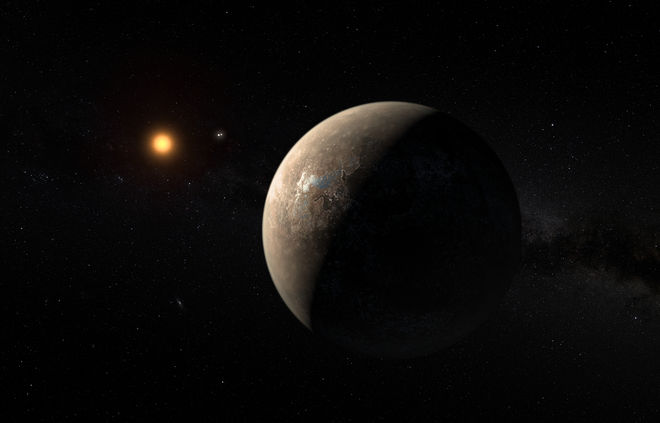Its often been said that Three’s a Charm! That is to say, in this case, three stars in the same system with a habitable Earth-like planet in the mix just for good measure! The Alpha Centauri Star System is a Trinary system – three stars linked by gravity, in orbit around a common center. What are the odds that not only is Alpha Centauri A a veritable twin of the sun but that now the same system is host to a planet very similar to the Earth?!
Known as Proxima b, the planet is a potentially Earth-like world orbiting Proxima Centauri – the closest star to our own sun. This historic find marks the closest exoplanet – and potentially habitable to boot – ever found.
Here, starting with this amazing artist’s concept of what the sky might look like from the surface of Proxima b, with Proxima Centauri (Alpha Centauri C) on the horizon and Alpha Centauri A and B, the other two stars of the system, higher up.
Proxima Centauri Orbit
Proxima b orbits Proxima Centauri (lower right), the closest stellar neighbor to our own sun. Proxima Centauri is the third and least massive member of the Alpha Centauri Trinary star system at about 4.22 light-years from the sun, while Alpha Centauri A and B are about 4.37 light-years away.

Exoplanet Proxima b
This artist’s impression shows the exoplanet Proxima b, orbiting the red dwarf star Proxima Centauri. Much further, the double star Alpha Centauri AB appears in the image between the exoplanet and its star. Estimates of Proxima b’s mass place it at least 1.3 Earth masses or about 30% more massive than our home planet.

European Southern Observatory in Chile telescopes
Proxima b was discovered by astronomers using a telescope array at the European Southern Observatory in Chile. The first mage below offers a view of the southern sky over the ESO’s 3.6-meter telescope at La Silla Observatory in Chile. The second image shows the stars Proxima Centauri (lower right) and the double star Alpha Centauri A & B (lower left), taken with the NASA/ESA Hubble Space Telescope.

Habitable Zone
The orbit of Proxima b is inside the cosmic sweet spot known as the “habitable zone” of Proxima Centauri, a region around every star where water can exist in a liquid state. A star’s habitable zone scales to its intrinsic luminosity (total output) in its limits and extent. Because of its feeble output compared to the sun, Proxima Centauri’s habitable zone is much closer to it and narrower than the sun’s habitable zone, as illustrated in this orbital diagram.

This announcement of an Earth-like planet found orbiting our closest stellar neighbor in space comes right on the heels of another historic and related announcement, the inauguration of the BreakThrough Starshot project where nanocraft will visit this star and the other two stars in the Alpha Centauri Trinary-star system within a generation.
Updates on this ongoing investigation can be found at The Pale Red Dot.


